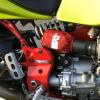Leaderboard
Popular Content
Showing content with the highest reputation on 10/08/2021 in all areas
-
I don't know if it's allowed and besides I don't want to start posting pictures of somebody else's bike However on the COG forum I just noticed a thread opened up by a new member of the Group. Thread title "New Centaurist Says Hello" Somebody at some point has Supercharged a Centauro!!! This is just a link to the forum index, easy to find the thread. http://www.centauro-owners.com/phpBB2/viewforum.php?f=1 I can't get my HiCam to run standard without frying, I'm feeeling SOOOO inadequate1 point
-
I did what PO18guy did and then went to the local mom & pop cycle speed shop for the terminal ends. I believe I reused the wire boot up at the coil. The reason I replaced them was that the right plug cap was damaged in a fall by the PO and the fact that they were 18+ years old. ....I believe mine have the 5k resistor caps.1 point
-
If I'm right the OEM caps have a 5k resistor built in .1 point
-
Tuning sequence for a W5AM is ridiculously simple. Connect manometer and Guzzidiag, (Or whatever diagnostic tooling you use.) After you have set the valve lash to 4thou inlet and 6thou exhaust warm the engine up to >60*C and close both air bleeds. Hold the throttle open so the engine runs at 3,500-4,000 rpm and using the screw on the bell crank on the LH throttlebody balance the manifold depression at 'High Speed'. Once done let the throttle snap shut. Kill the engine with the kill switch and recalibrate the TPS and clear the self learning parameters, (The acquired fuel trims. This is only really necessary if running a closed loop map but just do it anyway.). Restart the motor and whichever side has the higher manifold depression? Open the air bleed on that throttlebody to restore equilibrium. Thats it! That is all there is to tuning a W5AM Guzzi, (Bellagio excepted.). Do NOT try and change the idle speed by messing with the throttle stop screw to close the butterflies of the TB's. The idle speed is hard coded into the map in the ECU and is controlled by an air over idle system with a mechanical air bleed called a stepper motor that stabilises the idle at its 'Target' by adding or subtracting air to influence the idle speed. This is also controlled by the ECU. The 'Target Idle' is adjustable but only within the map using a program like Tunerpro to manipulate it once it has been downloaded from the ECU. Once modified the new map has to be re-uploaded to the ECU. This shouldn't need doing if the bike is mechanically sound and tuned properly. There are few bikes easier to tune than a W5AM Guzzi. It probably takes about the same time as it took me to write this message.1 point
-
Those are legit. That is probably not a MOPAR number, though. The consensus has been that the number printed below the circuit diagram is probably a production run designation.1 point
-
1 point
-
Yes that would be nice to have and to hold............ in green or silver. Anyone? Cruel and unusual punishement Docc1 point
-
1 point
-
1 point
-
Thanks for the detailed replies. Sounds like the first step is a trip to the garage after dark to “observe” the plug caps. Then potentially replace both to eliminate that problem. After that tappets and then check the TPS and tune with Guzzidiag, then set slow running, then re-sett TPS. Then re check for problem, or ride away with a big shit eating grin and congratulate myself on my intelligence for writing to you lot! Somewhere on here was a complete “How to” for this sequence. Anyone remember where? With the state of my memory nowadays I am reluctant to leave it to what i thought i did last time! Thanks in advance.1 point
-
Got the cancel email this morning! "Todaycomponents.com" should rename themselves "Yesterdaycomponents.com" lol.... Their website was not updated to reflect the zero stock. I am going to go with the "R1" which I found on eBay.1 point
-
If you upload to your album the size is irrelevant. I never resize when using the way I described. Don't open the image from your album just "copy image" from the album and paste in your post. I open a separate browser for the "copy image" and then switch browsers to the post browser and paste. Ciao1 point
-
These are rated at 40 amps and as you point out will fit in all receptacles. Paul B1 point
-
Correct! All the five relays currently installed are made in Portugal from Tyco. The starter motor relay is the only one with that "A403" spec. The others have "A103" or A203". Incidentally, I got two replies from two different sellers of "R1" OMRON G8HE; they don't know the difference. One stated that OMRON no longer manufactures either. I purchased 10; I will replace my current 5, and will have 5 spare. We can expect those to eventually go out of stock for good. We should maybe try to find a replacement that is still being manufactured today. Although the number of V11 Guzzi owners will decrease as we slowly vanish from earth. It appears the future will only be electric....1 point
-
Look at the data sheet from Omron: "R" stands for "Surge Suppressor". It is a built in resistor which is described at the line: coil rating: surge suppressor resistance.1/2 watt 680 ohms. I bet they updated the surge suppressor specs at some point and it became R1. @Pressureangle confirmed he installed an R1 on his bike with no trouble. When I did my search (I am not using Google by the way), the OMRON G8HE-1CT7T-R1-DC12 popped all the time. It seems it is easier to find, and may confirm it is a later spec. And before you ask: This is an SPDT relay type that stands for Single Pole Double Throw. IN the G8HE line there is also another type named SPST for Single Pole Single Throw.1 point
-
I found a company that had them in stock, same part, so I purchased them. https://www.todaycomponents.com/relay/omron-g8he-1c7t-r-dc12-relay.html1 point
-
I'll do my best, but they usually jam the mimeograph machine. They say I should be more careful with my graham crackers and milk. I think they're just lazy and don't want to crank the thing.1 point
-
Wow, Kiwi_Roy, exhaustive. I replaced the regulator after navigating through the V11lemans Tutorial Committee's advice and my bike is on the road and only needed human power for propulsion once since, a few days ago, when I ran it out of fuel. It has trained me well in the art pushing it around. I'm beginning to believe it learned a few tricks in an S & M dungeon and I'm its rube. I discovered a fried black wire in the harness under the seat a while back and appealed to the collective wisdom implicit here and ran a more robust wire from the regulator to ground. The electrical system seemed good enough to earn a grade of D, graded on a curve, in a class filled with Moto Guzzi addicts; until the regulator quit, was replaced and here I am still crying into my beer to anyone who'll listen. But it runs, only if I give it a drink of gasoline, but it is running. Almost overwhelming, the well written detail in your post. I do have a battery drain, it would be nice if I could vanquish it. I will cajole a friend who's education exceeds my kindergarten diploma in electrical/electronic summer camp to read over my shoulder and parse what you're recommending. He'll sketch a few illustrations in cartoon form and I'll get it. Thank you.1 point
-
Ha. Probably sorted - or simply got fed up with try this try that confetti approach to a remedy. Whenever remedies appear like minestrone soup - it’s time to simply stop - first, do no harm. Just attempting any fingers crossed fix in lieu a proper diagnosis first - is like a blind man in a dark room looking for a black cat that isn’t there. Frustrating.1 point
-
John asked me to look in on this thread, I used to know quite a bit about these systems. Firstly the alternator wires can be a problem, they snap off where they solder to the coils. When this happened to mine the copper was so corroded it was not possible to re-solder them so time for some new wires, its quite easy to solder the new copper to the coils. The bullet connectors where the regulator plugs into the stator leads often overheat, if this is a problem just chop the bullet connectors off and join to the alternator with crimp links or a solder joint. Grounding the regulator is critical, all the charging current travels back from the chassis to the regulator case so it can return to the alternator through the other yellow wire. The factory supply a small black wire from the case all the way to battery negative but this is far too small for the current involved. Run a short wire from the regulator case to a timing cover screw, the engine and battery main ground are massive compared to the tiny black wire. The regulator has a rectifier set up as a bridge, 2 diodes and 2 Silicon Controlled Rectifiers. The rectifiers sometimes go open circuit, this situation is very easy to set for if you have a meter with the diode test function, The diodes are connected from each yellow wire to the red wire, it should show about 0.5 Volt, since the diodes are between each yellow wire and the red pair its possible to add a diode on the outside. The way they measure the battery Voltage is very poor, it taps off the feed to the headlight after the headlight relay and in some cases a normally closed contact of the start relay. The relay contact and socket resistance changes with time, the Voltage drop can be anything from 0.6 to 1 Volt, I have a theory that the reference voltage drop approaches 1 Voltmeaning the battery Voltage has to be pushed above 15 to supply the regulator reference, this high Voltage demands more current which overheats the diodes unit the leads melt off. A warning sign can be the headlight out or the tachometer not working, chances are the battery is not charging and of course the charge light also fed from the headlight relay won't be working either fooling you into thinking everything is ok. I often thought of getting the Voltage reference from a different source downstream of the ignition switch, off one of the ECU relays or from a dedicated relay direct from the battery. This would give the regulator a lower Voltage reference because it expects a drop through the relay but it could easily be compensated for with some resistance ora diode in series. I struggled with this flakey Voltage reference for years then I upgraded to a permanently connected regulator from Electrosport, there was one minor drawback a parasitic drain on the battery, I used to disconnect the regulator over the winter but if you don't remember to re-connect it next thing you know the bike dies with a flat battery. Electrosport recommend their ESR515, I dont agree, it still relies on the flakey Voltage reference and a good ground connection. I used the ESR510 it is wired direct to the battery and it has a dedicated ground wire I don't think it supports the charge light. Instead of a charge light I recommend just purchase a battery Voltmeter for ~ $15 and hook it downstream of the ignition switch this will leave you in no doubt. https://www.amazon.com/12V-Voltmeter-Color-Digital-Display/dp/B07HHTZ1L5/ref=sr_1_46?dchild=1&keywords=12+volt+battery+meter&qid=1633586264&sr=8-461 point
-
(Settling around the campfire, tamping corncob pipe..) Reminds me of my old friend Bill, that told me of a rescue operation of a DC3 in Mexico. The electrical system was inop, so they knotted a big rope, wound it around the prop shaft, put a bunch of Mexicans on the end, and started pulling. Dang if it didn't start, but the rope didn't come off, and the knot was hammering the side of the fuselage. Started the second one the same way, and flew it out. Bill is *quite* a character.. need I say? and has had some adventures in his 97 (!) years.1 point
-
1 point













